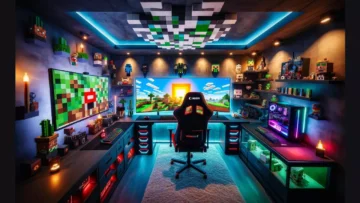So, you have decided to get into PC gaming. Maybe you are tired of consoles, or you want better graphics, or you just want to see what all the hype is about. Whatever the reason -welcome.
But let’s be honest. If you are new to this, it’s easy to get overwhelmed. GPUs, RAM, frame rates, Steam, RGB everything… it sounds like a lot.
And if you’re not careful, you could end up spending more money than you need to or worse, buying stuff that doesn’t even work together.
Why PC Gaming Is Worth It
Before anything else, let’s clear one thing up: yes, PC gaming can get expensive, but it doesn’t have to.
Here’s why people choose it:
- More game options: From AAA titles to weird indie gems, PCs give you access to way more games.
- Better graphics & speed: A decent gaming PC can run games smoother than most consoles.
- Mods: You can tweak and customize games, sometimes completely changing how they look or work.
- Upgrades: Instead of buying a new console every few years, you can just upgrade parts.
You’re not stuck with what a console maker decides is “good enough.” You’re in control.
What You Actually Need to Start PC Gaming
Forget the tech jargon for a minute. Here’s a simple list of the core things you’ll need:
- A gaming PC (prebuilt or custom)
- A monitor
- Keyboard & mouse (or a controller if you prefer)
- Headphones or speakers
- Internet connection
- An account on a game platform (like Steam, Epic Games, etc.)
That’s it.
You don’t need to drop ₹1,50,000 to start. You can build or buy something decent around ₹50,000–₹70,000 if you’re smart about it.
Prebuilt vs. Custom PC: Which Should You Choose?
If you’re just starting out, this decision can be annoying. Here’s a simple way to look at it:
Prebuilt PCs
- Plug & play. No hassle.
- Usually comes with support & warranty.
- Slightly more expensive for the same specs.
Custom PCs
- More performance for your money.
- You can choose every part.
- Requires time, research, or help from someone who knows their stuff.
My take? If you’re not into tech or just want to start playing ASAP, go for a prebuilt. Once you’re more confident, you can look into custom builds later.
Minimum Specs to Look For (2025 Update)
Don’t get lost in specs. Just aim for something that can handle most games at 1080p without lagging.
Here’s a safe baseline for beginners:
- CPU: AMD Ryzen 5 or Intel Core i5 (12th gen or higher)
- GPU: 4GB VRAM
- RAM: 16 GB
- Storage: At least 500 GB SSD
- Monitor: Full HD (1080p), 60–75 Hz is enough to start
This setup will run most modern games smoothly. You can always upgrade later.
Where to Buy Games
No need to walk into a store. Digital platforms are where it’s at:
- Steam: The most popular. Regular discounts & tons of games.
- Epic Games Store: Gives away free games weekly.
- GOG: Great for older games with no DRM.
- Xbox Game Pass for PC: Subscription model. Tons of games for a monthly fee.
Tip: Don’t buy games blindly. Look up gameplay videos or reviews. No one wants to spend ₹3,000 on a boring game.
Also Read:
21 Best Offline PC Games
Must-Have Accessories (That Actually Matter)
Skip the flashy RGB junk. Focus on comfort & performance:
- Mechanical keyboard: Feels better & lasts longer.
- Gaming mouse: Better accuracy for shooters & fast-paced games.
- Controller: Ideal for racing, platformers, or console ports.
- Good headset: Audio can make or break your gaming experience.
- A decent chair: Your back will thank you after long sessions.
Start simple. Upgrade only when you feel the need.
Beginner-Friendly Games to Start With
You don’t need to jump into sweaty multiplayer games right away. Here are a few fun, easy-to-pick-up titles:
- Stardew Valley – Chill farming & relationship sim
- Portal 2 – Puzzles with humor & great design
- Rocket League – Soccer with cars (yes, it’s as fun as it sounds)
- Hades – Fast action with a great story
- Minecraft – Build, explore, survive, your pace, your style
Start with games you enjoy, not just what’s trending.
Also Read:
16 Best PC Games under 10GB Size
Performance Tips Without the Nerd Talk
You don’t need to overclock or mess with BIOS. Just a few easy things:
- Close background apps before gaming
- Keep drivers updated (especially graphics)
- Use “High Performance” mode in power settings
- Tweak in-game settings – Lower shadows & effects for smoother gameplay
Even small tweaks can make a big difference.
Should You Go Laptop or Desktop?
Here’s a quick breakdown:
- Laptop = Portable, compact, usually more expensive for the same power.
- Desktop = Better value, easier to upgrade, but not portable.
If you’re a student or someone who moves around a lot, a gaming laptop makes sense. Otherwise, go desktop.
Final Advice: Don’t Stress the Setup
Every gamer starts somewhere. You don’t need the “perfect” rig to enjoy games.
Ask questions. Join gaming subreddits. Watch beginner PC setup videos. Most of the gaming community is pretty helpful if you’re respectful.
And remember, gaming is supposed to be fun. Don’t let tech overwhelm you. Start small, upgrade later, and just enjoy the experience.




